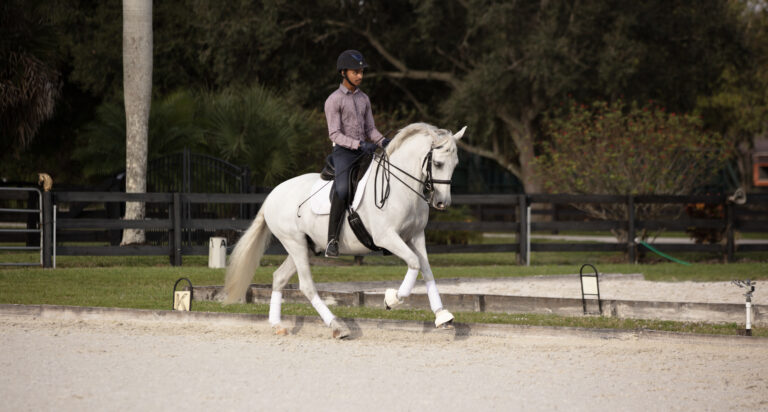Remarkable 54, an off-the-track Thoroughbred I’ve been training for four months, runs and jumps alongside me around the Kentucky Horse Park arena. There is no halter or bridle to connect us. The crowd claps and whoops, and Remarkable kicks out and runs away from me. His adrenaline is flowing. He sees the banners and flags and tosses his head. As he tears around the ring he thinks: “Where am I going?” Then, “Oh yeah,” he says to himself. “There is Tik. I want to go to him. That is a good place.”
When he turns, he looks at me with both eyes. The world shrinks around us. There is just a long, narrow tunnel leading from his eyes to my body. I lean back and invite him toward me. He canters, then trots up to me. He stops in front of me and we both take a deep breath. After a few seconds he lowers his head and licks and chews. In a little while he yawns.
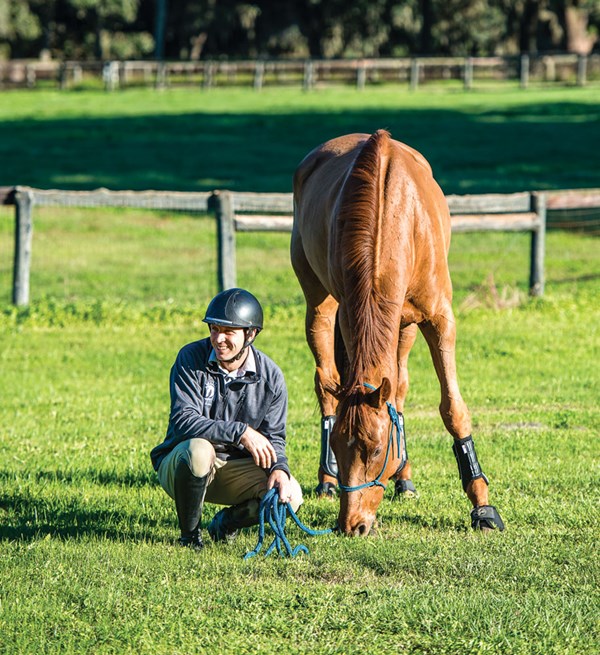
Remarkable and I won the freestyle class of the Retired Racehorse Project’s 2015 Thoroughbred Makeover. I explained some of the training concepts I followed to accomplish that goal in Practical Horseman’s February issue. This month, I’ll describe some techniques in more detail.
Like any other areas of horsemanship, these ground skills take years to learn—in fact, the learning never ends. Besides being just plain fun, they develop your relationship with your horse and establish your role as his teacher and mentor. This, in turn, will benefit every other activity you do with him, either on the ground or in the saddle. The better a teacher you are, the better your results will be.
Communicate
Being a good teacher requires communication and motivation. On the ground, you communicate with your voice, body language, lead rope and stick. I’ll explain these tools in more detail in a moment, but first I want to emphasize the importance of being consistent, clear and disciplined in how you use them.
Imagine you’re learning a new language, like Mandarin. If you were taught to use the same word to go in or out of a door or to sit down, that language wouldn’t make any sense to you. I use very specific cues to tell my horses exactly what I want them to do. For example, when I want a horse to walk, I make a kissing noise. When I want him to trot, I cluck. When I want him to canter, I cluck twice. I use the same sounds every time I ask.
In addition to my voice, when working with horses on the ground, I also use a rope halter and what’s commonly known as a “horseman’s stick.” This has a similar length to a dressage whip, with a longer lash and a slightly firmer feel. I find it very versatile. I can use it to scratch a big horse’s withers or rub a mare’s neck. I might run it down a young horse’s hind legs if he has a habit of kicking out when they’re touched.
I use a rope halter with a 12-foot lead because it provides a greater range of action. Its narrower pressure provides more control when I need it but the lighter weight makes it more rewarding when a horse isn’t leaning against it.
When I begin working with a horse on the ground, I create energy with the stick and then direct that energy with the rope. As with all riding aids, there are progressive levels of using each ground aid. Level 1 is a small cue, like moving the stick on the ground. Level 2 would be raising it off the ground. Level 3 would bring the whip in contact with the horse. For Level 4, imagine George Morris using a crop to school a horse who’s behind his leg.
How you progress through these levels depends on whether you’re using these aids to teach a horse something new, to reinforce a lesson or to refine his response. If the lesson is brand new, you would progress from Level 1 to 1½ to 2, and so on. If you are reinforcing a lesson that a horse already understands, you might progress more rapidly through the levels or even skip a level, for example, from Level 1 to 3 or 4.
The only time you would not begin an aid at Level 1 is in a dangerous situation. In an emergency, there’s no time for subtlety. Otherwise, always start with the lightest aid possible.
Being consistent with your body language is just as important as all of your other aids. People don’t tend to be as aware of what they’re doing with their bodies as horses are. Your horse notices which way you turn your shoulders, how you shift your weight from one foot to the other and whether or not you make direct eye contact. You can probably teach him to follow any part of your body, but the torso is the biggest, most obvious part.
It’s also important to be very clear with your intention. Intention is more than just your body language; it is the angles and the energy you exert relative to where your horse is.
Motivate
Your other job as a teacher is to motivate your horse. Training techniques and tools vary by discipline, but the way horses learn does not. If I am not getting the results I want, I ask myself first, “Does he understand what I want?” Second, “Is he motivated to do what I want? And how am I motivating him?” Horses can be motivated by fear, but I would rather my horse be motivated by enjoyment, comfort and an understanding of the purpose of the exercise.
There are three positive things that motivate horses: 1) a need to feel safe and comfortable, 2) curiosity and a desire to play (especially among young horses), and 3) food. I do use cookies and carrots quite often in my training—usually, however, not as a bribe, but as a reward. For example, I would not try to tempt a horse into a stall with treats. Instead, I would give him a treat as a reward afterward.
Different horses are motivated by different things. With many horses, simply the release of pressure (from the halter or stick) is enough. Some horses enjoy cantering around the arena. Others appreciate a rest, scratch or rub.
It’s your job to figure out what motivates your particular horse. Once you do, you’ll be able to use that knowledge, for example, to get his attention when he’s distracted. Think of a classroom of kids preoccupied by a rowdy game of soccer outside their window. Some teachers might close the window or ask the soccer players to move—but the best teachers find something more interesting to grab the students’ attention.
Keep these principles in mind as you try the exercises that follow. If you are new to natural horsemanship, familiarize yourself with the techniques first by taking a clinic, reading books or watching videos. Set yourself up for success. Perform your initial sessions in an enclosed, grass-free arena when no other horses are around so your horse won’t be distracted. And keep your expectations realistic.
Create “Draw”
For the Makeover, I wanted to be able to let Remarkable gallop at liberty in the stadium, surrounded by spectators and loud music. Then I wanted him to dependably come back to me. To do this, I had to create “draw.” Draw is a force, like a magnet, that brings your horse toward you. Horses are born with innate draws. A wild mustang may travel miles up a ridge to find a breeze that keeps the mosquitoes off her. A stallion may be drawn to a mare or a foal to her mother. It’s hard to find a horse who isn’t drawn to grass.
Draw is also created through experience. A horse is not born wanting to be with people but most can learn it easily enough. Often a horse’s stall has a big draw, which is why many horses speed up on the way home.
Horses often go through a series of emotions when confronted with something new: fear, curiosity, sometimes dominance or playfulness and, finally, indifference. Sometimes, if the novelty is continually rewarding in some way, draw is created.
I used the following three exercises to create draw with Remarkable. In the four months we had to get ready for the Thoroughbred Makeover, I worked with him about five days a week. I spent about three-quarters of those sessions riding and a quarter doing groundwork. The groundwork sessions sometimes lasted only 10 minutes. The more consistent I was with my expectations and cues, the more consistently and enthusiastically he responded. As we progressed, I tested our skills under more distracting circumstances, such as at a show or in front of a crowd.
I use the rope and halter for these exercises to begin with, reminding myself that the goal is to use less rope, less force and more communication as we progress.
Exercise 1: Mirror Me
For the Makeover, I wanted Remarkable to be able to stay by my left or right side, at any speed, with a high degree of relaxation and understanding—and, eventually, to do it with no halter or lead rope. Telling myself that we were training for the “Olympics of Leading,” I followed these steps:
Step 1. I use the rope, but don’t rely on it. When I am first teaching a horse to lead, I want his ears to be next to my shoulders. Eventually I want to be able to lead him from any distance and, at times, with him in front of or behind me. I use the rope to guide or correct for safety, but I do not use it to ask. Instead, I use my body language: leaning slightly forward to walk on, bringing my shoulders above my hips to halt and leaning slightly back as I walk backward—all the while expecting the horse to keep his ears by my shoulders.
If I don’t get the response I want, I add a little pressure with the stick or rope. When he obliges, I reward him. (I will even reward him for not giving the right answer if he at least tries.)
Throughout each session, I want my horse to be focused on me. If he gets distracted, instead of disciplining him, I give him something to do–for example, I may ask him to make more transitions, turns, halts or rein backs. Then, when I’ve regained his focus, I reward him.
Step 2. We go a little out of our comfort zone. We go from a walk to a trot. We add in turns, first at the walk, then the trot. I turn with my body before I pull on the rope, expecting him to read my body language. Going straight is easier for him than turning, so that can be a reward as well.
Step 3. I test how much I use the rope. I do this by seeing if I can hold the rope in an open palm or by putting the rope around the horse’s neck. Or I might simply imagine that the rope is made of string that will break if I have to rely on it. I am careful to balance constant improvement with being ready to abort or change plans if things start to get out of control.
Both this exercise and the following one are easy to overdo and can cause sourness, resentment or boredom. So limit your sessions to about 10 minutes or so.
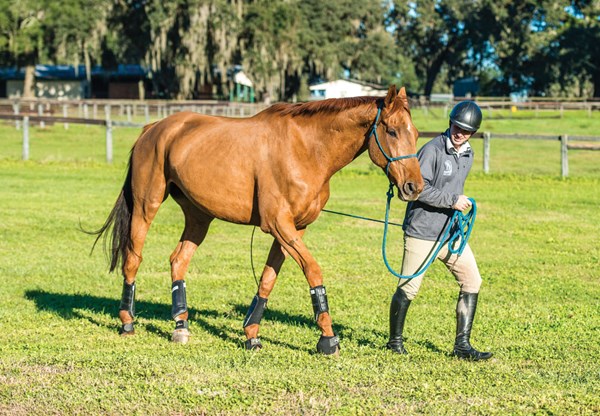
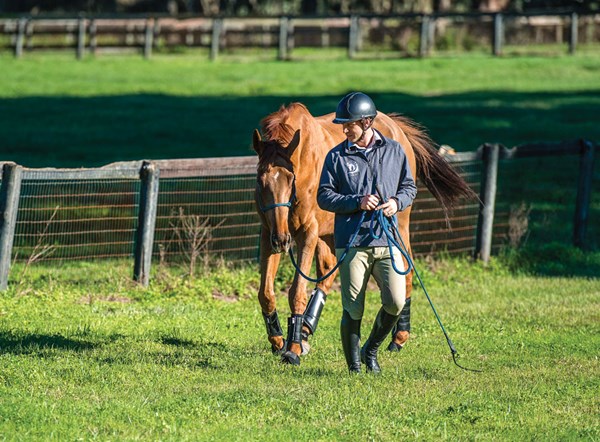




Exercise 2: Fill the Vacuum
Step 1. I back away at the walk. To draw my horse to me, I wait for him to look at me with both eyes, then lean away from him to create a “vacuum.” I want him to try to fill in that gap between us. If I step backward more quickly, I want him to hustle. When he makes a good effort, I take a break and give him a rub between the eyes.
Step 2. I add in changes of direction. When he looks left, I go right. When he looks right, I go left. I want to be the most important thing in his world at that moment. Not only am I working on changes of direction, I am working on keeping his attention and keeping the exercises interesting.
At this point I am getting good at walking backward!
Step 3. I add in a few steps of trot. I jog backward so my horse has to trot to catch me. I walk and then run a few steps. When he tries hard to stay with me, I give him a break.
Do not overdo this exercise. Horses learn better when you keep it fresh, rather than drilling it.
As your speed increases and you later progress to doing this work from more of a distance, it’s important to be extremely aware of where your horse is and what he’s doing. Even gentle horses occasionally strike out or kick up their heels for fun. When your eyes aren’t on your horse, listen to his movements and changes in gait.

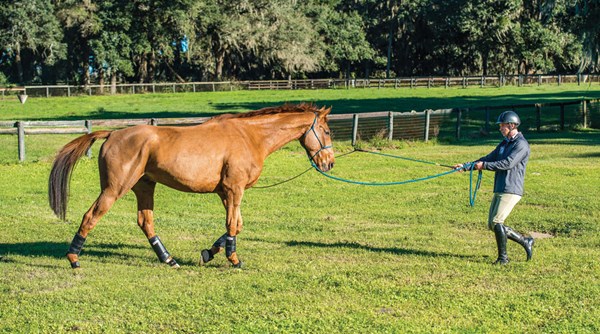
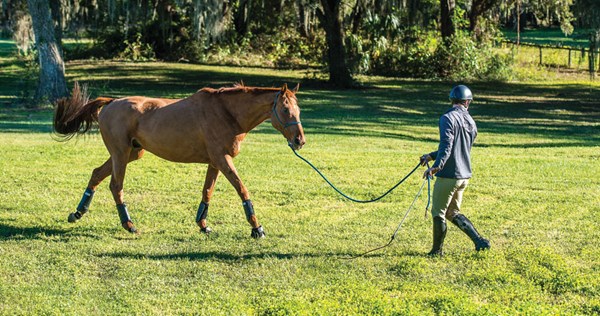
Exercise 3: Spend Undemanding Time Together
I stand next to Remarkable in a roundpen or field. I don’t rub or scratch him. He doesn’t nuzzle me. I don’t give him treats and he is not expecting any. We are simply comfortable in each other’s space. Neither of us expects anything in return at this point. This is what I call undemanding time.
Other times I do give him a rub or a carrot (or two), but the prerequisite for that is undemanding time. It is something I come back to whenever needed or just to reinforce the idea that we don’t do something every time I see him.
In contrast to the previous exercises, it is difficult to overdo spending undemanding time with your horse. Here’s how to achieve it:
Step 1. I make sure we are safe. Young horses, mares, geldings and stallions all react differently to these exercises. (Do not try this with a stallion. Stallions are more likely to come at you, instead of to you.) I want my horse to hang out with me and not come into my personal space unless he is invited.
One of the characteristics that separate good trainers from great trainers is an ability to be creative in their training, to change plans and to know when to back down (and when not to back down). Boundaries are so important, but it doesn’t mean you have to be aggressive. Be a tree. The tree has consistent boundaries—it is not confrontational, it simply is. On the other hand, if your horse nudges you and you step backward, you’ve just taught him that he can move you. Instead, be clear and firm about your boundaries.
Step 2. I try to understand what my horse likes to increase draw. This is something that will change over time. One day my horse might be more interested in just hanging out. Another day we may need to move around a bit—walk and trot in different directions, stop, back up, make turns—before he is ready to settle down. Whenever I think I start to understand him, I remind myself I could always understand him more.
If he steps away from me, I don’t worry about it. I gently and firmly draw him back to me with my body language first and the rope second.
Step 3. I spend undemanding time with my horse in many different places and situations. I imagine a relaxed horse in the wild, walking and grazing. Mature horses do not run much unless they are anxious or spooked or chased. Young horses like to play, of course, and I remind myself this is not a bad thing. I try, when a horse is curious or playful, to encourage him as much as possible, considering the context and safety of where we are. For example, when Remarkable wants to gallop around an enclosed, empty field, I don’t discourage that.
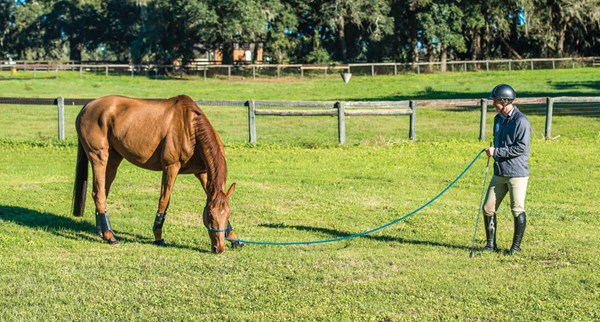
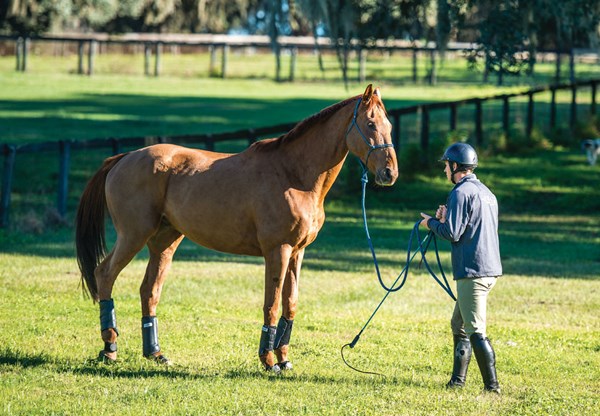




Finding Inspiration
I watch the trainers I admire and I reflect on why I respect them. Why am I drawn to them? Although technique is my starting point, it always has to do with something more than just technical skill, something deeper in the soul. It’s the same with horses.
Different trainers have various ideas about what is important. The dressage rider Charles de Kunffy says courage is the characteristic that must precede all others. Pat Parelli preaches “positive, progressive and natural.” Ray Hunt, in a tear-jerking eulogy to Tom Dorrance, says horsemen “need to practice only three things: patience, observation and humility.”
When I am struggling with my horsemanship or riding, I look to four things: patience, empathy, thoughtfulness and enthusiasm. If I am not getting somewhere or not enjoying the process, it is usually because I am missing one of these virtues.
About Tik Maynard
Eventer and natural horsemanship advocate Tik Maynard spent six years on the Canadian National Team competing in the modern pentathlon, which includes riding, pistol shooting, fencing, swimming and running. He competed in the sport at the 2007 Pan American Games, three World Championships and 11 World Cups before focusing his competitive sights on eventing. He was long-listed for the Canadian eventing team for the 2012 London Olympics and currently is long-listed for the national eventing team. He has been a working student for eventers David and Karen O’Connor and Ingrid Klimke, German dressage trainer Johann Hinnemann and natural horseman and cutting trainer Bruce Logan. He also worked as an assistant trainer for show-jumper Anne Kursinski. Married to eventer Sinead Halpin, Tik conducts eventing and natural horsemanship clinics throughout the United States, Canada and the United Kingdom. Last December, he spoke at the U.S. Eventing Association’s Annual Meeting about “How Horses Learn.” For more information, go to www.tik.ca.
This article originally appeared in the July 2016 issue of Practical Horseman.





